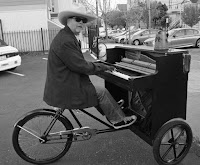 Today's post is a follow up on a recent post related to the changes to ABRSM Theory from next year, which I reported on in an earlier post. It seems they are aware of some concerns of many and have issued a reply. I am interested whether you think their response is adequate - really listening to teachers, so please leave a comment below. It goes as follows:
Today's post is a follow up on a recent post related to the changes to ABRSM Theory from next year, which I reported on in an earlier post. It seems they are aware of some concerns of many and have issued a reply. I am interested whether you think their response is adequate - really listening to teachers, so please leave a comment below. It goes as follows:
A healthy debate
News of the updated exam papers has led to some debate. We know from research and recent feedback that many people welcome these changes. We also know that some teachers have concerns and I’m going to write about some of these here.

The value of theory
Learning about music theory and the way music works is such an important part of any music education. It gives students the tools they need to get the most from their musical activities, whatever they might be. Because of the value we place on music theory, we’ve recently spent time reviewing the exams. We want to ensure that they assess the right things in the right way, are encouraging and supportive, and give candidates the best opportunity to demonstrate their knowledge and understanding.
Responsibility, consultation and research
Each year thousands of candidates all over the world take ABRSM exams. As an awarding organisation monitored by official regulatory authorities, we take our responsibilities very seriously. This involves reviewing and refreshing all our assessments on a regular basis, a process which is always founded on consultation and research. We talk to experts. We listen to teachers and students. And we take into account best practice in assessment and question design – not just in the world of music but more widely as well.
In reviewing our Music Theory exams at Grades 1 to 5 we followed all these steps. The result? We’re making a number of small changes. We’re modernizing the exam papers and focusing more clearly on the building blocks of music theory – the essential tools that give students access to future musical progress and opportunities. And while there’s a small change in the skills needed in certain parts of the exam papers, the underlying knowledge students need to cover and the standard of the exams is staying the same.
What about creativity?
As part of this process we’re removing rhythm-writing, melody-writing and word-setting questions at Grades 1 to 5. Some teachers are concerned that this might reduce opportunities for students to be creative. However, while we would always encourage creativity in learning, research tells us that these questions are often answered in a way which suggests a formulaic or even ‘space-filling’ approach. So following consultation we decided to replace these questions. This has allowed us to focus more on the ‘nuts and bolts’ of music theory, give candidates extra opportunities to demonstrate their knowledge in this area, and increase objectivity and consistency in the exam marking.
I’d also like to reassure everyone that we are not replacing these questions to make the exams easier. In particular, at Grade 5 we are continuing to ask candidates to apply their knowledge in a wider context when they answer questions on musical extracts. This is something which requires a similar approach to the melody-writing question and calls on similar higher-level thinking. So, importantly, the knowledge and understanding candidates need is not changing.
Moving up to Grade 6
There is also a concern that without melody-writing at Grade 5, candidates who want to carry on to Grade 6 Music Theory, with its requirement to write original music, might not be adequately prepared.
It might help here to explore the difference between Grades 1 to 5 and 6 to 8. In many ways, these two sets of grades have different roles to play. At 1 to 5, the focus is on developing a good grasp of the basic principles of music theory. The revised papers now reflect this more clearly. Grades 6 to 8 then give opportunities to demonstrate this knowledge in an applied and more creative way.
When making the changes at Grades 1 to 5, we’ve been careful to ensure that despite the slight shift in focus at Grades 1 to 5, the step-up from 5 to 6 won’t change. Once students have passed Grade 5 they should have the tools they need to start tackling the different requirements of the higher grades.
Why multiple choice?
One result of our research into question design is the introduction of multiple choice questions for musical terms and signs. Multiple choice questions are widely accepted as an effective assessment method and they will be familiar to the majority of candidates from their experience of taking other tests and exams. But does this mean we’re ‘dumbing down’? Absolutely not. When multiple-choice questions are well-designed, the likelihood of being able to give correct answers through guess-work is very small. We are continuing to assess a full range of terms and signs, and candidates still need to learn these thoroughly to do well in this section of the exam.
So what do you think? Does this response answer any concerns you may have had about the changes. Please do leave a comment below and let's have as ABRSM calls it, some "Healthy debate" .

















